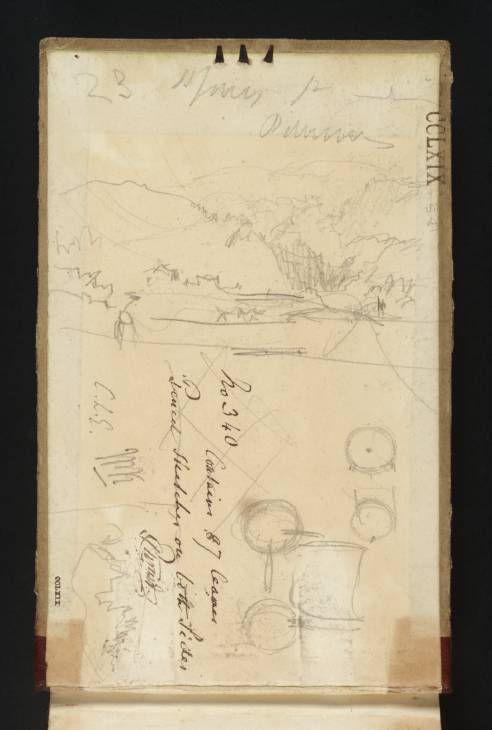Joseph Mallord William Turner Sketches and Inscriptions: Castle Campbell; Diagrams; 23 St James's Place 1834
Image 1 of 2
-
 Joseph Mallord William Turner, Sketches and Inscriptions: Castle Campbell; Diagrams; 23 St James's Place 1834 (Inside front cover of sketchbook)Inside front cover of sketchbook
Joseph Mallord William Turner, Sketches and Inscriptions: Castle Campbell; Diagrams; 23 St James's Place 1834 (Inside front cover of sketchbook)Inside front cover of sketchbook -
 Joseph Mallord William Turner, Sketches and Inscriptions: Castle Campbell; Diagrams; 23 St James's Place 1834 (Enhanced image)Enhanced image
Joseph Mallord William Turner, Sketches and Inscriptions: Castle Campbell; Diagrams; 23 St James's Place 1834 (Enhanced image)Enhanced image
Inside front cover of sketchbook
Joseph Mallord William Turner,
Sketches and Inscriptions: Castle Campbell; Diagrams; 23 St James's Place
1834
(Inside front cover of sketchbook)
Joseph Mallord William Turner 1775–1851
Inside front cover:
Sketches and Inscriptions: Castle Campbell; Diagrams; 23 St James’s Place 1834
D41047
Pencil on off-white wove paper, 183 x 113 mm
Inscribed in pencil by Turner ‘23 St James p | Picadilly’ top
Blindstamped with the Turner Bequest stamp centre left descending vertically
Inscribed in brown ink by Henry Trimmer ‘no 340 Contains 87 leaves | Pencil sketches on both sides | [signed] HS Trimmer’ centre descending vertically
Signed in pencil by Charles Lock Eastlake ‘C.L.E.’ centre left descending vertically
Signed in pencil by John Prescott Knight ‘JPK’ descending vertically beneath Trimmer’s signature
Inscribed in pencil ‘581’ upper right descending vertically
Stamped in black ‘CCLXIX’ top right descending vertically
Stamped in black ‘CCLXIX’ bottom left descending vertically
Inscribed in pencil by Turner ‘23 St James p | Picadilly’ top
Blindstamped with the Turner Bequest stamp centre left descending vertically
Inscribed in brown ink by Henry Trimmer ‘no 340 Contains 87 leaves | Pencil sketches on both sides | [signed] HS Trimmer’ centre descending vertically
Signed in pencil by Charles Lock Eastlake ‘C.L.E.’ centre left descending vertically
Signed in pencil by John Prescott Knight ‘JPK’ descending vertically beneath Trimmer’s signature
Inscribed in pencil ‘581’ upper right descending vertically
Stamped in black ‘CCLXIX’ top right descending vertically
Stamped in black ‘CCLXIX’ bottom left descending vertically
Accepted by the nation as part of the Turner Bequest 1856
References
1909
A.J. Finberg, A Complete Inventory of the Drawings of the Turner Bequest, London 1909, vol.II, p.864.
The variety of apparently unconnected sketches and inscriptions here suggest that Turner returned to the inside front cover of the Stirling and Edinburgh sketchbook on several occasions to make quick sketches and notations.
At the top of the page Turner noted an address: ‘23 St James[’s] P[lace] Piccadilly’. The Survey of London records that this house was in the 1830s occupied by the merchant and banker, Sir John William Lubbock.1 Turner had no known connection to Lubbock, but he did have strong connections with his next-door neighbour at number twenty-two, the poet Samuel Rogers.2 Rogers was a friend of Turner’s and in 1834, when this sketchbook was used in Scotland, Turner’s vignette illustrations to Roger’s Poems were published. This note may therefore have been made in connection to a visit or correspondence with the poet over the matter of the illustrations. Turner’s confusion with the address may be explained by the fact that numbers 22 and 23 St James’s Place were attached properties and had previously been a single dwelling,3 Though it is perhaps more likely that he had simply been careless.
The scribbled sketch across the top half of the page depicts a hilly landscape (perhaps inscribed ‘hills’ at the left) with a bridge or fence in the foreground at the lower centre and buildings at the left. The landscape has a similar appearance to sketches of Castle Campbell as seen from the town of Dollar on folio 70 verso of this sketchbook (D26393) and in the Loch Ard sketchbook (Tate D26688; Turner Bequest CCLXXII 12). The square outline of the castle is perhaps visible at the upper centre of the present sketch. Another sketch, boxed-off at the bottom left of the page and drawn with the book turned to the right, depicts a ruin in a landscape which may also be Castle Campbell.
Across the lower half of the page are several studies of vehicles or machinery. The square with two circles beneath it could be a crude representation of a coach or carriage (see folio 1; D26259), or perhaps a pulley. The grid or lattice at the centre of the page is related to another sketch on folio 1 that depicts some kind of lifting mechanism.
Inscribed in brown ink across these diagrams are the endorsements of Turner’s executors; see the inscription line for a transcription.
Thomas Ardill
February 2011
How to cite
Thomas Ardill, ‘Sketches and Inscriptions: Castle Campbell; Diagrams; 23 St James’s Place 1834 by Joseph Mallord William Turner’, catalogue entry, February 2011, in David Blayney Brown (ed.), J.M.W. Turner: Sketchbooks, Drawings and Watercolours, Tate Research Publication, December 2012, https://www

